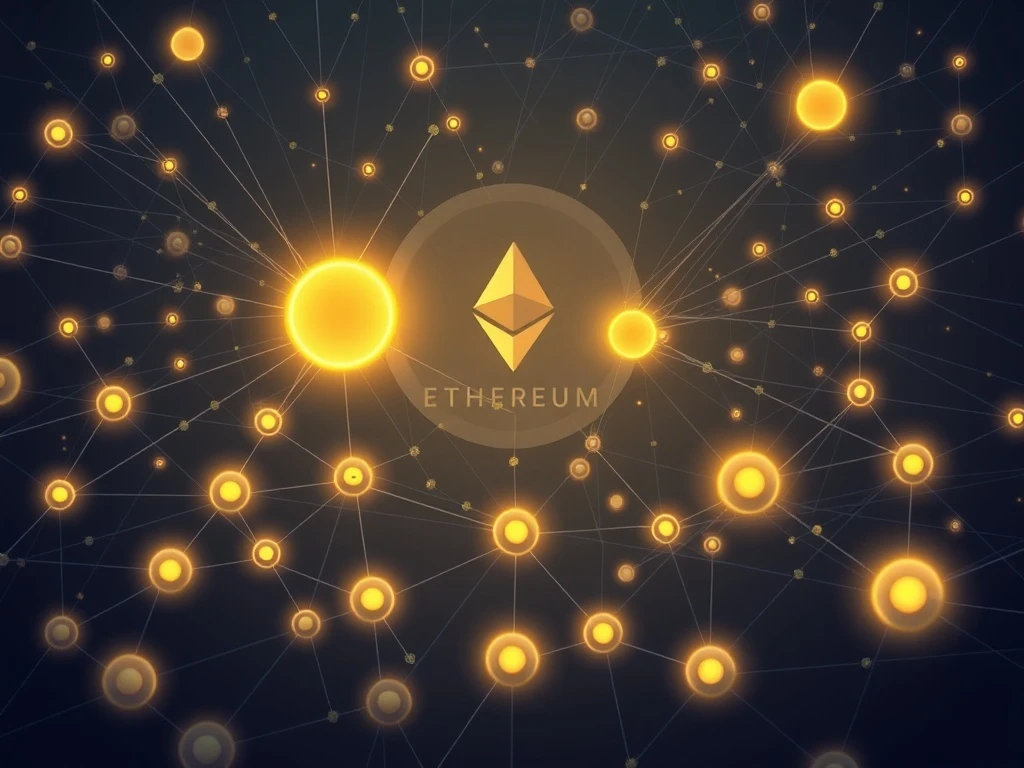Ethereum MEV: Alarming Centralization Threatens Network’s Core Principles

Are you following the pulse of Ethereum news today? If so, you’ve likely heard whispers, or perhaps even shouts, about the growing concerns surrounding Ethereum’s Maximal Extractable Value (MEV) landscape. It’s a critical topic that strikes at the very heart of the network’s decentralization ethos, and recent findings paint a concerning picture of power concentrating in just a few hands. This isn’t just technical jargon; it’s about the fairness and integrity of the world’s leading smart contract platform.
Understanding Ethereum MEV: What’s the Big Deal?
Before diving into the centralization dilemma, let’s quickly demystify Ethereum MEV. In simple terms, MEV refers to the maximum value that can be extracted from block production in excess of the standard block reward and gas fees by including, excluding, or reordering transactions within a block. Think of it like this: on a busy highway, some drivers might pay extra to use a VIP lane to get to their destination faster or to cut ahead of others for a specific advantage.
After Ethereum’s monumental Merge, which transitioned the network from Proof-of-Work (PoW) to Proof-of-Stake (PoS), the mechanism for block production changed significantly. The introduction of the Proposer-Builder Separation (PBS) model aimed to improve efficiency and mitigate some MEV-related issues. Under PBS, block proposers (validators) and block builders are distinct roles:
- Proposers: These are the validators chosen to propose the next block. Their role is to select a complete block provided by a builder.
- Builders: These specialized entities construct the actual blocks, deciding which transactions to include and in what order, aiming to maximize their profit.
While PBS was designed to enhance the network, it inadvertently created a new vector for power concentration. Builders, with their sophisticated algorithms and direct connections, can identify and execute profitable MEV strategies, such as arbitrage, liquidations, and sandwich attacks, by carefully ordering transactions within the blocks they construct.
The Alarming Rise of Centralized MEV Extraction
Recent research, specifically a study titled “Measuring CEX-DEX Extracted Value and Searcher Profitability: The Darkest of the MEV Dark Forest,” has shone a spotlight on a troubling trend: the increasing centralization of MEV extraction. The study reveals that a mere three block builders—beaverbuild, Titan, and rsync—now dominate an astonishing 65% of all transactions on the Ethereum network. This isn’t just a minor shift; it’s a significant concentration of power that could have profound implications.
How are these dominant players achieving such a high market share? It largely comes down to two key factors:
- Exclusive Contracts: These top block builders often form exclusive partnerships with arbitrageurs and large trading firms. These firms pay higher fees to ensure their lucrative transactions (like cross-exchange arbitrage) are prioritized and appear first in blocks. This creates a ‘VIP lane’ where profits are locked in for privileged players, leaving smaller participants at a severe disadvantage.
- Self-Building Capabilities: Some of these entities are vertically integrated, meaning they are not only builders but also run their own searchers (the entities that identify MEV opportunities). This allows them to internalize the entire MEV extraction process, giving them an unparalleled edge over independent searchers or validators.
This dynamic means that the promise of a fair and open playing field, where anyone can participate and profit based on merit, is being eroded. Smaller validators and independent arbitrageurs find it increasingly difficult to compete, leading to a less diverse and potentially less resilient ecosystem.
Why Ethereum Decentralization is Under Threat
The core ethos of Ethereum, and indeed most blockchains, is decentralization. It’s the very foundation that ensures censorship resistance, security, and trustless operation. When a handful of block builders gain such significant control over transaction ordering, several critical risks emerge:
- Censorship Risk: A concentrated group of builders could theoretically collude to censor specific transactions or exclude certain addresses from blocks. While currently hypothetical, the technical capability exists, which undermines the network’s neutrality and permissionless nature.
- Reduced Fairness: The ‘VIP lane’ phenomenon creates an uneven playing field. Those without privileged access or deep pockets are systematically disadvantaged, making it harder for new innovators and smaller participants to thrive.
- Stifled Innovation: If the most profitable MEV opportunities are monopolized, there’s less incentive for independent developers and researchers to innovate in MEV extraction methods or to build tools that benefit the broader community.
- Erosion of Trust: If users perceive the network as being controlled by a few powerful entities, it erodes trust in its foundational principles, potentially deterring future adoption and investment.
This situation highlights a complex dilemma: how to balance the efficiency and profitability offered by MEV with the fundamental need to preserve Ethereum’s decentralized nature.
Community Solutions and the Path Forward for Proposer-Builder Separation
Thankfully, the Ethereum community is not sitting idly by. Developers and researchers are acutely aware of these centralization risks and are actively exploring solutions to mitigate them. Several promising proposals are on the table:
- Enshrined PBS (ePBS): This is a major proposal that aims to bake the Proposer-Builder Separation directly into the Ethereum protocol itself. The goal of ePBS is to randomize block builder selection, making it much harder for any single entity or small group to consistently dominate block production. By decoupling the builder from the proposer at the protocol level, it could significantly reduce the power of large builders to dictate transaction orderings.
- MEV-burn Mechanisms: Another innovative approach involves mechanisms that would redistribute or ‘burn’ (destroy) a portion of the extracted MEV. By reducing the overall profitability of aggressive MEV extraction, these mechanisms aim to lessen the incentive for extreme centralization and promote more equitable distribution of value. This could involve sending a portion of MEV to the network, validators, or even back to users.
- Increased Transparency Tools: Efforts are also underway to develop better tools for monitoring block builder behavior. Greater transparency allows the community to scrutinize how blocks are constructed, identify potential collusion or unfair practices, and hold builders accountable. This data-driven approach can inform future protocol adjustments and foster a healthier ecosystem.
These solutions underscore the ongoing commitment of the Ethereum community to its core values. It’s a testament to the network’s adaptive nature that it can identify and address such complex challenges through collaborative governance and continuous innovation.
The Crucial Balance: Efficiency vs. Decentralization
The centralization of MEV extraction serves as a stark reminder that even well-intentioned innovations can have unforeseen consequences. While MEV is a natural byproduct of a high-value blockchain, its current trajectory poses a significant challenge to Ethereum’s long-term viability and its alignment with its core principles of decentralization, fairness, and censorship resistance.
The debate over MEV is far from over, but the focus remains clear: finding a delicate balance between maximizing network efficiency and safeguarding its decentralized infrastructure. As Ethereum continues to evolve, the proactive engagement of its developers, researchers, and community members will be paramount in ensuring that the network remains robust, equitable, and true to its founding vision for all participants.
Frequently Asked Questions (FAQs)
Q1: What is Maximal Extractable Value (MEV) in Ethereum?
A1: Maximal Extractable Value (MEV) refers to the maximum value that can be extracted from block production beyond the standard block reward and gas fees. This is achieved by including, excluding, or reordering transactions within a block to gain a financial advantage, such as through arbitrage, liquidations, or sandwich attacks.
Q2: How does Proposer-Builder Separation (PBS) relate to MEV centralization?
A2: Proposer-Builder Separation (PBS) divides the roles of creating a block (builder) and proposing it to the network (proposer). While intended to improve efficiency, it has inadvertently allowed specialized block builders to optimize for MEV extraction, leading to a concentration of power as a few dominant builders can secure exclusive contracts or self-build for maximum profit.
Q3: Which block builders are currently dominating MEV extraction?
A3: According to recent research, three entities—beaverbuild, Titan, and rsync—currently dominate a significant portion (around 65%) of transaction ordering and MEV extraction on the Ethereum network.
Q4: What are the risks of MEV centralization for Ethereum?
A4: The centralization of MEV extraction poses several risks, including potential transaction censorship, an unfair playing field for smaller participants, stifled innovation due to monopolized opportunities, and an erosion of trust in Ethereum’s core principle of decentralization.
Q5: What solutions are being explored to mitigate MEV centralization?
A5: The Ethereum community is actively exploring solutions such as Enshrined PBS (ePBS) to randomize block builder selection, MEV-burn mechanisms to reduce the profitability of aggressive MEV extraction, and developing tools for increased transparency to monitor builder behavior and ensure accountability.










